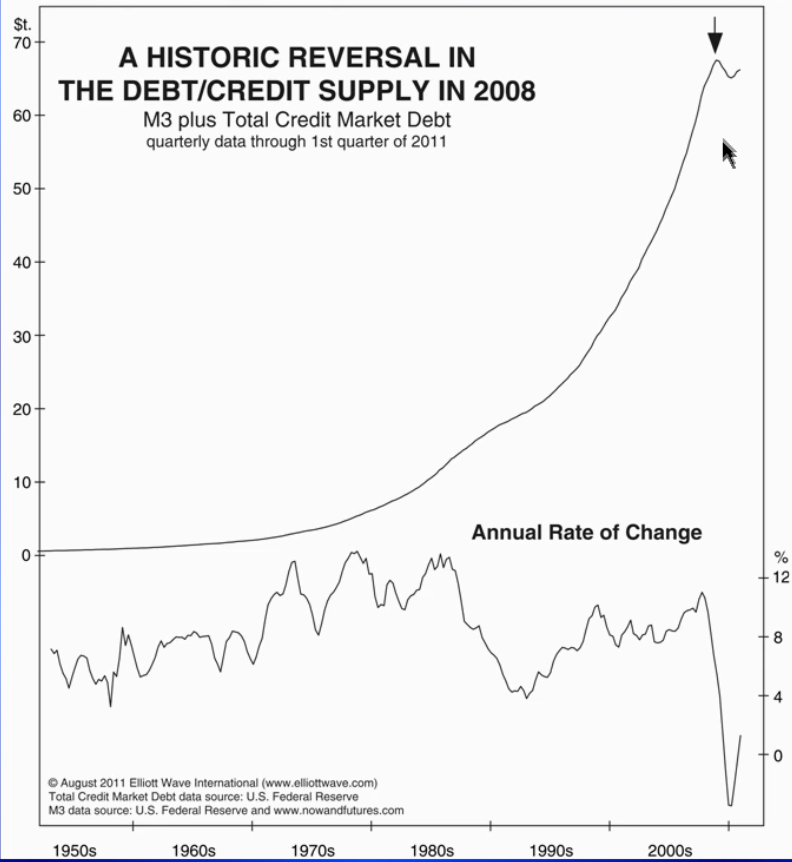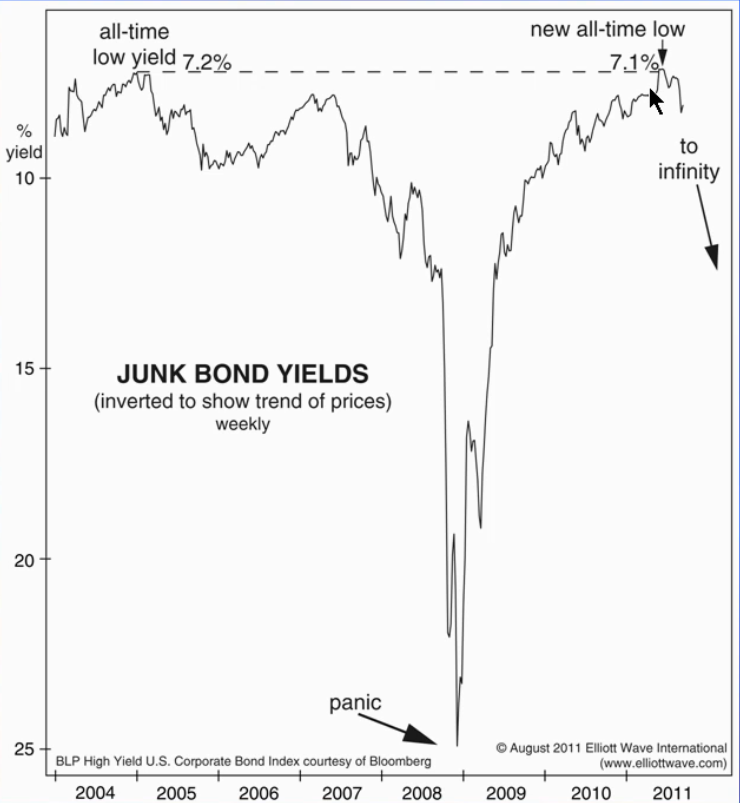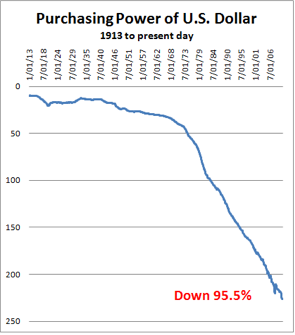Market Opinion
The answer is Debt began to implode in 2008. As you can see on this first chart below, debt has been growing constantly since the 1930’s, it got into a parabolic rise in the 1990’s and 2000’s and all these new dollars in terms of IOU’s are what supported the Real Estate Blowoff of ’06, the Tech Bubble ’00, and the Stock Boom in general to ’07.

That Debt/Credit supply reversed in 2008, had a slight bounce during market/economic recovery from 08′. But this trend is exhausted, and the first reversal in the trend in 80 years argues strongly that a big drop in Debt/Credit is occurring and our future is a Deflationary Depression of epic proportions.
What is the major component of the Debit/Credit line above? Mortgages . You can see in the chart below that Mortages actually peaked in 2005, a year before the Real Estate market peaked in the USA. You can also see below that the number of mortgages fell to a new low last year in 2010 when an Economic recovery was supposed to be in motion.

Complacency at an all time low as measured by Junk Bonds precedes an imminent collapse. Junk bonds actually made a new all time high price in April of 2011, taking out the optimism of the high’s in 2005. A new decline has begun, more debt liquidation on the horizon and these trash bonds are about to emulate Greek Bonds.

The Dow Jones Industrials rose 330 points (2.97 %) and the NASDAQ (up 87, 3.5%) and the S&P 500 (up 39, 3.41%) followed suit. S&P small caps were up 4.16%! Perhaps more important the Philadelphia Bank index appreciated 5.26% on the day
Last week we brought to your attention a world-class emerging shale play happening in Argentina’s Neuquén Basin.
The potential here for unconventional oil & gas development is enormous by any measure. A number of companies are well positioned to grow and prosper, including a few junior companies with significant land holdings.
In part 2 of our story below, my colleague and guest writer Michel Maassad of BeatingTheIndex.comshares his unique insights on those juniors… in what he calls “an opportunity of a lifetime.”
– Keith
P.S. Neither Michel nor I own shares in any of the securities covered below.
SIGNS OF THE TIMES:
“Global Meltdown: Investors Are Dumping Nearly Everything”
– CNBC, September 22
“The lack of direction from European leaders is troublesome for investors looking for some profound announcement coming from European leaders as to what they’re going to do to rectify the crisis.”
– CNN Money Report, September 23
We have often noted that policymaking has been a scam that only appears to work when the business and stock market cycles are trending up. And as was heard on the old and dreadful Vancouver Stock Exchange “So long as the stock is going up the public will believe the most absurd stories.”
One of the most absurd promotions has been that a committee of wise economists can manage the economy, and so long as they could keep credit expanding they had the public’s confidence.
Since April, they have been unable to keep things from going down and are losing credibility.
Another quote shows growing frustration:
“Investors just want to know, even if it is just a Band-Aid, that there’s some cure that’s going to be announced.”
– Chief Investment Strategist, September 23
“Divided We Fail – The World Needs Quick & Collective Action”
– Economy Watch, September 27
a) The main belief has been that policymakers have the ability to prevent bad things from happening.
b) Another one is that when “bad” happens it can be rectified.
If “a” was valid, “b” would not be necessary.
These have been the two main theories that have been around since Bagehot floated them in 1873 – as that bubble was concluding. That post-bubble contraction prevailed from 1873 to 1895.
In 1929 Bagehot was in the minds of central bankers and the Fed discounted liberally during that impossible crash. They have followed the same policy on this contraction, which is now being seen as ineffective.
In the early 1930s the establishment understood that the crash was caused by the bubble. The SEC and Glass-Steagall acts were intended to prevent another bubble and they did not work.
Essentially since the 1960s, interventionist economists have assumed that the Fed is a perfect instrument and revised history in blaming Fed leadership for erroneously tightening credit. Newspapers of the day report that the Fed was trying to inflate credit.
As any trader would know – liquidity disappeared – as it does following any great financial mania.
The other part of the above quote about “Divided…” included “We need a strong political will around the world.”
Policymakers and their toadies sense that their great interventions are not working. Rather than criticizing central banking as a perfect instrument, the establishment is laying the blame upon individuals. The old ad hominemargument in 21st century guise.
The problem continues with the establishment being overweight theories and underweight common sense. A painful rebalancing continues.
* * * * *
Perspective
Lady Bountiful has been in retreat as the tag team of Mother Nature and Mister Margin wrest control from policymakers. Actually, the Fed never really has had control over the treasury curve and credit spreads.
The brain-dead “Operation Twist” did not work when earnestly imposed in the 1960s, and now is quickly being seen as doubtful policy. Independent of this folly, long-dated treasuries have had an outstanding run.
The action is working on a major top, which the “Twist” is helping create.
Chubby Checker and his important hit of 1960 – “The Twist” is in the financial media. Many of today’s central bankers were not of age then, and may not know one of the variations “Let’s Twist Again”.
The establishment will be discussing damage control, but it is too early for us to do a full post mortem.
This hit is confirming that seasonally September can be bad.
So can October, but it is also known as the month that ends panics.
On the bounce out of August we wondered if that hit was enough to clear the air. We concluded that the relentless widening of corporate spreads would overwhelm the possibility of either an engineered or natural end to the pressures.
The question now is the same. Is it over?
The Dow is making the third test of the August low.
Corporate bonds from the Baa out to Junk continue to decline in price as spreads widen.
Baa yields have increased by 20 bps as the spread widened by 20 bps. At the other end, Junk yields increased by 92 bps with 100 beeps of widening.
As spreads reversed to widening in May we thought it would trend towards possible dislocation in the fall. That’s what usually happens at the end of a cyclical party in spreads. The change so far is significant, but not in a panic.
In so many words, this sector was in the “Get me in!” mode (“GMI!”) into April. It is not yet “GMO!”.
Policymaking
“No warning can save people determined to grow suddenly rich.”
The observation was made by Lord Overstone, a prominent banker, in the mid-1800s. History shows that during an era of financial speculation virtually all facets of a society participate – one way or another. The observation means that there is nothing that can be done to prevent or curb speculation – when it is time.
Given the cyclical nature of market history, the opposite condition holds. And that is when a financial mania completes there is nothing anyone or any agency can do to prevent a speculative collapse – when it is time.
That occurred with the 2008 Crash. The first business cycle out of that crash started in June 2009 and likely ended in May of this year. That would be with the speculative highs for stocks, corporate bonds and commodities.
Today’s financial problems have often occurred and are due to exceptional speculation by individuals, corporations and government.
Remedies that were exciting and revolutionary in the early 1930s have become the established way of doing things. The problem is that Keynes and his disciples were so ignorant of financial history that they thought that personal revelations were new science. Worse, some of the ideas were so old that they dated back to Ancient Rome.
It can be said that the distortions induced by Rome’s version of the New Deal contributed to its ultimate failure.
However, when it was on it was celebrated as the “Genius of the Emperor”, but it was used by the bureaucracy to change the country from a republic to a police state.
More recently, the notion that throwing credit at a credit contraction will make it go away dates back Edward Missleden who had a personal revelation inspired the hardship initiated by the banking crash of 1618 to 1623.
Understandably, such wisdom seems mainly to be “revealed” in desperate financial conditions. The next important example was made by John Law (the first truly reckless modern central banker) following the end of a long and dynamic expansion in 1716.
The next such discovery about using credit to prevent a credit contraction was made by Walter Bagehot who was editor of The Economist as the 1873 bubble was topping.
Keynes seemed unaware that bubbles were dangerous and suffered a significant loss during the 1929 Crash. He “took a bath” and thoroughly perplexed invented the “liquidity preference”.
Markets have a way of creating genius. The old saying is that the higher a bull market goes the more geniuses there are. A variation is that the moment someone with a PhD in currency and interest-rate manipulation gets appointed as Fed Chairman he becomes a genius.
Even greater accolades are visited upon the government official who, by fate, presides over a “new financial era”. Andrew Mellon was Treasury Secretary during the “Roaring Twenties” and was celebrated as the greatest since Alexander Hamilton. Then Robert Rubin had the watch when another new financial era began, and was granted the accolade.
Volatility during Ben Bernanke’s reign will deny the accolade.
Nevertheless, Bernanke has been appointed to genius status, whose latest exercise in tautology is noted on the attached chart.
A recent FT article on the latest in rescue plans observes that it “requires psychiatric rather than financial assessment.”
The reason for this is that the “new” concept “would have the features of a CDO of a CDO, a highly leveraged security which proved toxic in 2007-2008”. With the contraction it seems that financial wizards in the brokerage business found refuge in government.
Clearly, policymakers have become fanatical and the latest experiment will not work. The literature provides no evidence of the senior central bank ever preventing a full-blown financial mania, which supports Overstone’s observation. There is no evidence of the senior central bank ever preventing a severe and lengthy post-bubble contraction.
STOCK MARKETS
Commodities and corporate bonds are making new lows for the move that started in April. Volatility prevails in the stock market such that it continues to test the August low.
The latter seems to be the most responsive to the “rescues” engineered by increasingly desperate fanatics. Quite likely, commodity and bond traders are more skeptical than stock investors are.
Our work in April suggested a cyclical bear for stocks, commodities and corporate bonds that could last for more than a year.
We will stay with that, but we are uncertain about the action in October.
Link to September 30, 2011 ‘Bob and Phil Show’ on Howestreet.com:
http://talkdigitalnetwork.com/2011/09/quarter-blues/
“If inflation falls too low or inflation expectations fall too low, that would be something we have to respond to because we do not want deflation.”
– Ben Bernanke, September 29, 2011

· The Fed opened its doors for “business” in January, 1914.
· President Nixon stopped payments of gold in 1971.
· The only reason why Keynesianism and central banking are still in play is that it transfers wealth to the State.
· Bernanke’s recent observation is absurd.
INSTITUTIONAL ADVISORS
WEDNESDAY, OCTOBER 5, 2011
BOB HOYE
PUBLISHED BY INSTITUTIONAL ADVISORS
The above is part of Pivotal Events that was
published for our subscribers September 30, 2011.
We look forward to helping you make your first purchase or add to an existing position.










